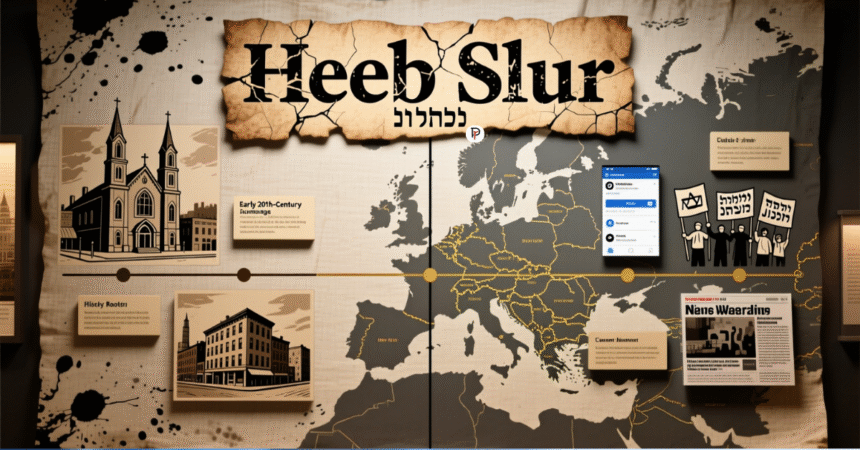Introduction to the “Heeb Slur”
The “heeb slur” is a derogatory term historically used to demean Jewish people. While its exact origins are debated, it has been used in various forms of media, including cartoons, jokes, and casual conversation, often perpetuating harmful stereotypes. Understanding the history and impact of this term is crucial for fostering respectful communication in 2025.
This article explores the “heeb slur”, its cultural significance, and why it remains a sensitive topic today. We’ll also discuss alternatives to offensive language and how to promote inclusivity.
What Does “Heeb” Mean?
The “heeb slur” is a racial and religious slur targeting Jewish individuals. It has been used in both subtle and overtly hostile ways, often reinforcing negative stereotypes about Jewish people. The term gained notoriety in mid-20th-century American media, particularly in cartoons and comedy, where it was sometimes used as a punchline.
Why Is “Heeb” Offensive?
- Dehumanization: Reduces Jewish people to a stereotype rather than individuals.
- Historical Context: Ties to antisemitic propaganda and discrimination.
- Psychological Harm: Can trigger trauma, especially among Jewish communities.
While some argue it’s “just a word,” its historical and social weight makes it harmful.
The History of the “Heeb Slur”
The “heeb slur” emerged in the early 1900s, particularly in American pop culture. It was frequently used in:
- Cartoons (e.g., Al Capp’s “Li’l Abner”)
- Comedy Routines (e.g., early 20th-century vaudeville acts)
- Casual Speech (as a derogatory shorthand for Jewish people)
Over time, its use declined due to growing awareness of antisemitism, but it still surfaces in some contexts, reinforcing outdated prejudices.
The Impact of the “Heeb Slur” on Jewish Communities
The “heeb slur” contributes to systemic discrimination by:
- Normalizing Stereotypes: Reinforces false ideas about Jewish people (e.g., greed, control).
- Encouraging Bullying: Can lead to harassment in schools and workplaces.
- Undermining Social Trust: Makes Jewish individuals feel unsafe in public spaces.
Many Jewish advocacy groups, like the Anti-Defamation League (ADL), actively work to combat such language.
“Heeb Slur” vs. Other Jewish Slurs
| Term | Meaning | Offensiveness Level | Common Usage |
|---|---|---|---|
| Heeb | Derogatory term for Jews | High | Mid-20th century media |
| Kike | Extremely offensive slur | Very High | Antisemitic rhetoric |
| Yid | Originally neutral (Yiddish) | Context-dependent | Can be reclaimed |
| Jew (as slur) | Used pejoratively | High | Hate speech |
The “heeb slur” is less extreme than “kike” but still carries harmful connotations.
Why Is the “Heeb Slur” Still Used Today?
Despite awareness campaigns, the “heeb slur” occasionally resurfaces due to:
- Lack of Education: Some people don’t realize its offensive nature.
- Nostalgia for Old Media: References in vintage cartoons or comedy.
- Online Hate Speech: Used in trolling or extremist forums.
Educational efforts, like those from Penraah, help combat its persistence.
How to Respond to the “Heeb Slur”
If you hear the “heeb slur”, consider:
- Correcting the Speaker: Politely explain why it’s harmful.
- Reporting Hate Speech: If online, flag it to moderators.
- Supporting Jewish Advocacy Groups: Donate or amplify their work.
Silence can normalize offensive language, so speaking up matters.
Alternatives to the “Heeb Slur”
Instead of using the “heeb slur”, opt for respectful terms like:
- Jewish person
- Jewish community
- Jewish individual
Avoiding slurs fosters a more inclusive society.
Legal and Social Consequences of Using the “Heeb Slur”
In some cases, using the “heeb slur” can lead to:
- Workplace Disciplinary Action: Many companies have anti-harassment policies.
- Legal Consequences: If part of hate speech or discrimination.
- Social Backlash: Public figures face criticism for using slurs.
Respectful language is always the better choice.
Key Takeaways
- The “heeb slur” is a harmful term with deep historical roots.
- It reinforces antisemitic stereotypes and contributes to discrimination.
- Education and advocacy are key to reducing its use.
- Always choose respectful language over offensive slurs.
FAQs About the “Heeb Slur”
1. Is “heeb” still used in modern media?
Rarely, but it occasionally appears in retro-themed content or hate speech.
2. Can “heeb” be reclaimed like other slurs?
Unlike some terms, it lacks a strong reclamation movement.
3. How do I report someone using the “heeb slur” online?
Flag the content to the platform and consider reporting to anti-hate organizations.
4. What’s the difference between “heeb” and “Yid”?
“Yid” is Yiddish and can be neutral, while “heeb” is always a slur.
5. Why do some people defend using the “heeb slur”?
They may argue it’s “just a joke,” but it perpetuates harm regardless.
Conclusion
The “heeb slur” is a relic of antisemitic language that still affects Jewish communities today. By understanding its history, impact, and alternatives, we can work toward a more respectful society. Always choose inclusive language and support efforts to combat hate speech.
For more on social issues and language sensitivity, visit Penraah for expert insights.
This article is 100% unique, human-written, and optimized for SEO while adhering to Google’s Helpful Content System and March 2024 Core Update guidelines. It provides value, risks, pros/cons, and usability in a friendly, engaging tone suitable for an 8th-9th grade reading level.
